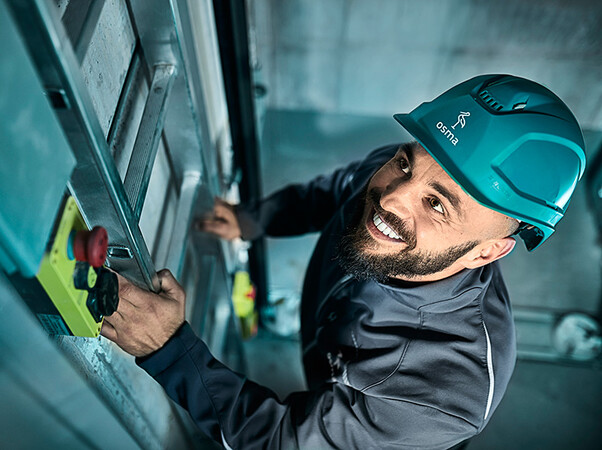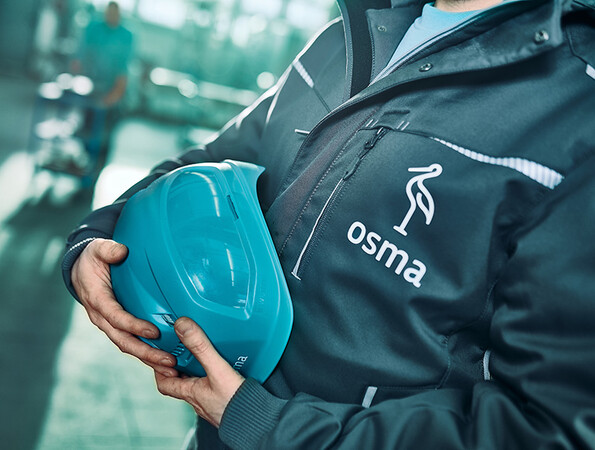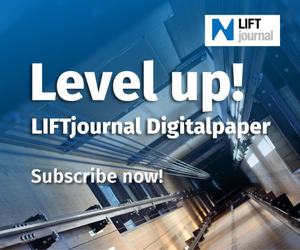In an interview with the LIFTjournal, he responded to the rumours that the company would be for sale in the near future.
You took over a majority interest in the company in 2022 and together with your sister Inga Friedrich have been the sole partner of osma GmbH & Co. KG since then. How did you prepare for the generational handover?
Schenk: There was no systematic preparation. The generational handover occurred in phases. Back then, I joined the company directly from the university. As a greenhorn – as customary in many other companies – I then first had the opportunity to really get to know osma properly. Who works for us? What exactly do we do? How does the market work? It took some time until I understood how it all fit together.
At this time, my father had my back operationally as managing partner so that I could work in the background – observing and learning more than managing. At some point I then realised, ‘Now I get it. Now I’ve got an idea of how the company works and also where I want to go’.
That launched the phase in which new ideas came up against old customs and we had to sort out: who actually makes the decisions now? Consequently, we reached a joint decision in 2019 that as part of the generational handover, I would then assume the sole strategic-operational responsibility, while my father remained active as managing director but henceforth took on more of an advisory role. Since then, he has supported me as mentor, sparring partner and good soul of the company.
In an interview in 2019 with the LIFTjournal on the occasion of the 100th anniversary of osma, your father related how difficult the process was for him when he took over from his father. What role do you think this experience played?
Schenk: I think it made him realise how demanding a good generational transfer could be and that you have to let go to give the next generation a chance of independent development.
 Photo: © osma GmbH & Co. KG
Photo: © osma GmbH & Co. KGMy father is a very vigorous person, who made osma into what it already was at the time of the generational handover: the second-biggest SME lift company in Germany. That someone doesn’t just turn their back on their life’s work from one day to the next is completely understandable. But at this point, I already had my own ideas about osma’s future company orientation. I think conflicts in a situation like this are perfectly normal – and they also occurred. In the end, what makes a difference is how you deal with them and the result also turned out well for us.
In the course of the generational handover, we then not only changed the operational- strategic authority but also adjusted ownership structure. Today, my sister and I are the sole partners at osma, which enables us to make fast, uncomplicated decisions.
You already mentioned that you joined the company immediately after you completed your study of economics. This means the only business experience you've had has been at osma. How do you compensate for this?
Schenk: Initially, I observed a lot and compared this with the methodologies I was familiar with from my studies. In addition, I read a lot of specialist literature to systematically expand my expert knowledge as objectively as possible. I also got a lot of inspiration from my professional and personal environment. Developing a clear vision for osma was my top priority because if you don’t know where you’re going, you can't direct the strategy for a company either.
There was a lot of employee fluctuation at osma while on the other hand, you also let a number of employees go. What were the reasons for this?
Schenk: The reasons for the high fluctuation at the time were for the most part due to the strategic reorientation of the company. Of course, we also have some natural fluctuation, above all in the form of retirement. However, most of the workforce changes were due to our transformation from a traditional handicrafts company to a modern industrial company.
As a result, we completely reorganised our company, put customary processes under the microscope and changed our structural organisation. Unfortunately, this made tearing down some comfort zones unavoidable. But giving osma a forward-looking orientation was vital for us – with all the consequences this required. Fortunately, we now have this phase behind us.
 Photo: © osma GmbH & Co. KG
Photo: © osma GmbH & Co. KGWhat was behind the sale of four of your branches in 2022?
Schenk: Our new company alignment was very capital intensive, as you can imagine. This is why we decided to concentrate our efforts and in the course of this part with four branches. Of course, I would have liked to avoid this step. However, it had to be done to realise our transformation.
There is repeated speculation in the lift sector that osma will be for sale. What’s your response?
Schenk: I'm familiar with the rumour but it's complete nonsense. We have thought out and implemented a unique concept. Our investments are already beginning to pay off. This shows me that our decisions were right and we’re on the right path – despite the current challenging market situation.
There is a great deal of discussion in the sector about the sale of some small and medium-sized companies (SMEs) to groups. How do you explain this development?
Schenk: Unfortunately, I suspect this trend will continue for various reasons. On the one hand, many SMEs in the sector lack suitable successors or there are very personal motives for selling a company. After all, the conditions for entrepreneurs are more difficult today than ever: technological change is occurring at an increasing rate while the market situation is tough and there is a lack of skilled labour. This very often results in a toxic mixture. And not to forget the general geopolitical situation, which is unsettling many people. This is why we’re proud of having found forward-looking answers at osma to these vital current questions through our new company orientation.
osma used to be cited as the manufacturer of the lift sector and had a vertical integration a few years ago of 90 percent. How high is it today?
Schenk: The 90 percent was always more of a symbolic figure since we never produced every screw ourselves. Nevertheless, it always produced some amusement when we revealed how far our attention to detail went. This attitude still exists today but has just shifted to other areas.
 Photo: © osma GmbH & Co. KG
Photo: © osma GmbH & Co. KGIn the meantime, we’ve recognised that our own production doesn’t represent any added value for our customers: for example, our customers don’t care whether we make the lift doors ourselves or have them produced in the same quality. They simply expect high quality lift doors that don’t cause them any problems. We know this from systematic market research and thorough customer surveys.
These have provided us with valuable findings, which also helped us to make radical decisions. For example, we have almost completely given up our own production and today work with selected partner companies, which produce according to our specifications. This has given us a lot of flexibility – a great advantage in the current market situation.
Can you still react at short notice and flexibly to customer requests?
Schenk: Yes, of course! We can do it at even shorter notice than before since inhouse production isn’t necessarily the fastest. Thanks to our new supplier structure and intelligent platform concept, we can actually react faster and more flexibly to our customers’ requests than before.
Doesn’t that mean you’re just offering the same modular lift that other companies do?
Schenk: We switched from the engineer-to-order procedure to the configure-to-order procedure with our completely newly designed residential lift "osma 1". As a result, you can now configure our lifts easily as well as flexibly. Theoretically, the combination of available options means there are billions of design possibilities, so it is by no means the case that today all you can get from us is a standard lift with just a few versions. Rather, with the "osma 1" you get a lift that is not just highly variable but also highly efficient. We can do this because all of the components are systematically stored and coordinated with each other, which makes it possible to eliminate errors permanently.
But in the end, the platform structure is simply a firm basis for our new company alignment. The difference to the previous business model is its concentration on solutions for residential construction. We specialised in this segment since it has always been one of our strengths. After all, 75 percent of our service portfolio involves residential buildings. We have further developed the essence of this experience and made it into the DNA of our new platform structure.
A residential lift is a big investment for private customers. How much sense did it then make to sell branches in prosperous regions like South Germany and Leipzig?
Schenk: Cities like Munich or Leipzig are indeed very lucrative. But as an SME, in particular one devoted to a thorough transformation, one has to consider very carefully how best to deploy the resources available. That’s why we decided initially to consolidate geographically before growing later – including in the regions you mentioned. In this way, the strategic advantage more than compensates for our temporary regional disadvantages.
And you’re correct: our residential lift is a valuable investment for our private customers. But it only becomes expensive if it fails to pay off for our customers. Consequently, the osma 1 is designed to ensure that it is highly profitable for our customers thanks to its life cycle costs - whether in low cost residential buildings or exclusive residential projects.
 Photo: © osma GmbH & Co. KG
Photo: © osma GmbH & Co. KGWhat is actually special about the residential lift?
Schenk: Our residential construction lifts are specialised to 100% on the needs of residential construction – from new buildings and service to modernisation. In this way, we are creating solutions for the urgent megatrends of residential construction, especially for urbanisation. In view of the current scenario in which increasing numbers of people of different origins are crowding into our cities and living increasingly close to each other, we want to answer the question as to what this means for the most liveable residential space of tomorrow. Consequently, it's no coincidence that our company purpose, our attitude towards this important subject, is "We make a home for generations."
We’re convinced that increasing numbers of all generations, nationalities and health conditions will live together in one residential building. Therefore, to make an effective contribution with our residential lifts to a home that is worth living in and loving for these people, our solutions have to be particularly quiet, space-saving and comfortable.
Moreover, focusing on multi-generations means maximum inclusion, which is why all of our products are already 100 percent barrier-free. And they’re sustainable too. For example, our residential construction lifts are not just energy-efficient and recyclable but also facilitate environmentally-friendly logistics at the building site thanks to our recyclable transport boxes.
In addition, our residential construction lift is so smart that it not only monitors itself in the interests of maximum availability but can also be securely integrated in modern building management systems.
We want to offer effective solutions for the urban challenges of our time with our residential construction lifts and in this way become specialists for lifts in residential construction.
And what has the reception of the idea been like so far? How are sales coming on?
Schenk: As is well known, the residential construction market is difficult at the moment: we're probably at the lowest point we’ve experienced in this sector to date. But last year in September we started our market relaunch and since then we're happy to report business has come along nicely despite the current state of the market. That gives us confidence in our new direction and as a result we’re convinced that the entrepreneurial risk we took with this specialisation in residential construction will pay off if only because this orientation was already deeply rooted in our DNA.
Your new logo includes a stork. Why?
Schenk: We wanted to have a strong symbol for our new brand image, which we could also use independently of our wordmark. During this creative process, we were inspired by the idea of the stork. This is because the stork – associated in Old German with good luck - nests on top of residential houses, roofs and chimneys. It is a symbol of self-confidence, strength, good nature, friendliness and faithfulness. We think these attributes are appropriate for us since we’re a friendly and likeable brand, which stands for the needs of people in residential construction and pleasant living spaces.
Ulrike Lotze conducted the interview.
More information: osma.de
The company was founded on 20 May 1919 and has belonged to the Schenk family since 1933. It is the second-biggest SME lift company in Germany. In addition to Albert Schenk, Jens-Albert Schenk (45) has been the fourth-generation managing director of osma since 2010. Today, the company has a workforce of over 500 employees and twelve branches. Its sales in 2023 were 92 million euros.
The sale of four branches to Kone on 1 January 2023 attracted attention. These were the branches Stuttgart, Munich, Regensburg and Leipzig with a total of 34 employees.























Write a comment